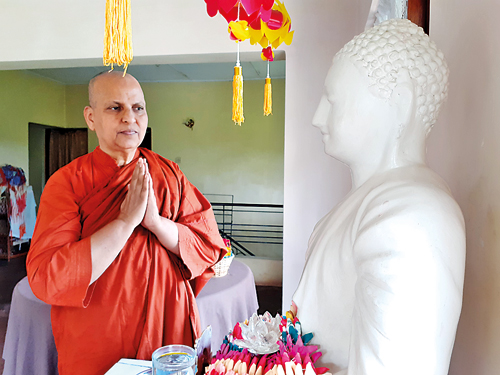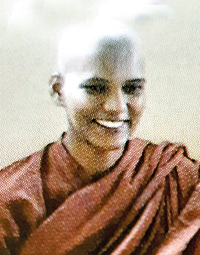Proper observation of ata-sil when we go to temple on Poya day

Meewaturé Dhammadinna Mehenin: Seeking the true essence of the Dhamma
When Mahaprajapathi Gothami with 500 Sakyan ladies went to the Buddha and asked for permission to join the order, there may have been among them, a mother and daughter who were ordained. But in the present world, it is a very rare occurrence.
Meewaturé Dhammadinna Mehenin, formerly Dr. Neeta Jayasinghe and Peradeniyé Dhammashanthi Mehenin, formerly Niluka Jayasinghe are a mother and daughter duo who have decided to traverse the path of the Dhamma taught by the Buddha, to improve their dhamma knowledge and achieve a higher state of mind.
Dhammadinna Mehenin Wahansa was a former senior lecturer in the Faculty of Medicine at Peradeniya University and later a lecturer in the University of Melbourne. After early retirement she returned to Sri Lanka and having studied the Dhamma under the guidance of the Most Ven. Madawala Punnaji Thera, was ordained in 2015.
Dhammashanthi Mehenin Wahansa studied at Monash University in Melbourne to become a lawyer. She worked for five years in Australia before giving up her lay life and returning to Sri Lanka. She too studied the Dhamma under the guidance of the Most Ven. Madawala Punnaji Thera and was ordained in 2014.
Speaking to the Sunday Times on the value of the Buddha’s teachings and, meditation, Dhammadinna Mehenin outlined how programmes should be conducted on Poya days in the temples, when people go to observe atasil.
She said, “Buddha’s teaching is profound and very methodical. One cannot go straight into meditation. Dana, sila, bhavana in this order will make a person achieve the desired goal of first achieving sotapana.”
Confined to her aramaya due to the COVID-19 pandemic, Dhammadinna Mehenin has written a book titled “Sotapatthi” which explains the Dhamma as the Buddha taught, as to how one can strive to achieve the final goal of Nirvana ending the samsaric life (being born again and again). “As a layman, one should get involved in dana, sila, bhavana. Dana (alms) is metta. Not only giving, it has to be offered after earning money honestly, not by cheating. Anyone can give dana. Even a dishonest indisciplined person who earns by wrong means such as distilling illicit brews can offer dana. But, that is not a good action. Dana is giving. Dana is letting go - metta. Dana should be given with compassion and kindness.”
The Buddha taught the pancha sila (five precepts). Sila is virtue or moral conduct. The practice of sila is defined in the Eightfold Path. “One should first follow the pancha sila. This is where the sila starts. Panchasila has two sections- kaya and vachanaya (body and word).”
“Why should one follow the pancha sila? Because we have a goal to achieve – calmness and purity of mind. Perfect purity and calmness is ‘Nibbana’. To reach that eventual goal, the beginning is the pancha sila. But many people do not understand why we follow the five precepts.”

Dhammashanthi Mehenin Wahansa on the day of her ordination
Panatipatha veramani siccapadam samadiami (refrain from killing); Adinna dana veramani sicca padam samadiami (refrain from stealing); Kamesumicca cara veramani sicca padam samadiami (refrain from sexual misconduct); Surameraya majjapama dattana veramani sicca padam samadiami (do not take intoxicants) – these are bodily (kaya) actions.
Musavada veramani siccapadam samadiami (do not lie, gossip, slander, insult, use harsh words). This explains the use of bad words (vachanaya).
“Even if one observes the pancha sila, it is not perfect sila, in the sense they are kriya (actions) and vachana (words) only,” the Mehenin Wahansa said. “If you want to reach a higher sila, you have to think. For this purpose, one has to be more aware of your thoughts (yonisomanasikaraya).The Buddha said sita, kaya, vachanaya (mind, body and words) – all three should be guarded. Even if you follow the pancha sila but if you are jealous, have anger, hatred, think about the past and future deeds and have regrets and sorrow, these are all unwholesome thoughts (ayonisomanasikaraya) - akusala karma.
The Buddha spoke of the kayakarma, vacikarma and manokarma. “One should ask the question, in Buddhist teachings which karma is more harmful, more important? The answer is manokarma (thoughts) as it all starts in the mind first. Thoughts have not only the akusala (bad) karma but also the kusala (good) karma.”
The first verse of the Dhammapada explains the significance of the mind.
“manopubbangama dhamma
manosetta manomaya
manasa ce padutthena
bhasati va karoti va
tato nan dukkham anveti
cakkam va vahato pandam”
-Dhammapada
“Mind precedes all mental states. Mind is their chief. They are all mind-wrought. If with an impure mind a person speaks or acts, suffering follows him like the wheel that follows the foot of the ox. (Translation from the Pali by Acharya Buddharakkhita)
“Buddha’s teaching is about the mind, how we can tame the mind and purify it. This is the essence of the Buddha’s teachings,” she added. “But unfortunately, many Buddhists do not give priority or make an attempt to follow Buddha’s teaching by purifying and training the mind for inner development. Instead, they call themselves Buddhists without following the actual Dhamma. But they are not the real Buddhists. They only develop Buddhist activities –amisa puja. This is Buddhist culture. Such activities are good. But Buddha has said it is more important to follow the prathipatthi (policies).
“But we must see why we spend so much time on amisa puja only. It is because people like activities, social activities, entertainment. In Asian countries this is very much so. Human beings are social beings and we have got used to community activities like listening to bana (discourses) and dana (giving alms). They have to be done while putting them into practice to purify our mind. The essence of the Buddha’s teachings is to purify our mind.
“Yes, the Buddha encouraged dana, because it is giving away and not being attached to material things and dispels greed. But dana alone will not suffice. Because the Buddha has taught us to dis pel three things – Loba (greed), Dvesha (hatred), Moha (delusion or ignorance). If one practises only dana, they will get worldly comforts in this life and afterwards. That is ‘Samsaric’ Buddhism. The essence of Buddha’s teachings is ‘Nirvana’ Buddhism–which is to end Samsaric suffering by dispelling Loba, Dvesha and Moha. (greed, hatred and delusion). In a nutshell, it is purification of our mind.
“The Buddha’s words were “although I pass away the Buddha kaya (body), anyone can still see me. One who sees the Dhamma sees me.”
Yo dhammo passathi so man passathi
Yo man passathi sodhamman passathi
“Buddha also taught saddha (devotion, piety) before teaching the dhamma. Worship is done to show gratitude and pay respect and build saddha. People have stopped at this level and not developed any further. This is where people have gone wrong. Why do we have saddha for the Buddha? Because of the Buddha’s wisdom of the dhamma.” With saddha people can contemplate on the higher qualities of the Buddha and search the path of the dhamma.
“There may be people who have achieved purification of the mind. During the Buddha’s time some people listened to his discourses, understood and reached the first stage of sovan. Buddha knew the level of the mind of people and who could understand the dhamma when he addressed them with his discourses.
“Before starting on meditation, you have to understand the Four Noble Truths (Ariya sathya) – dukka (suffering), samudaya (the origin of suffering), nirodha (cessation of suffering), magga (path to the cessation of suffering) and the Noble Eightfold Path (Ariya Atthangika-Magga) – samma ditthi (right view), samma sankappa (right thoughts), samma vaca (right speech), samma kamantha (right conduct), sammaajiva (right livelihood), samma vayama (right effort), samma sati (right mindfulness), samma samadhi (purity of mind). This was the Buddha’s first teachings in the Dhamma-chakkapavattana sutta.
“Buddha’s teachings emphasize the purification of the mind.
“People go to the temple on Poya day to observe ata-sil, to follow the eight precepts. Unfortunately, that has become a social activity. There should be a proper organized programme for the entire day such as Buddha puja, dhamma talks, guided meditation, question and answer sessions to guide the people but only a few temples have such programmes. At present, we see mainly the older generation observing ata-sil. It is the duty of the monks to give priority to planned and useful programmes so that even the younger generation will like to attend, as there are many young adults who wish to learn and understand what the Buddha has taught.”
“We have noticed competition among temples to build larger temples or expand the existing ones. Instead of building one big hall as a Dharmasala many are building and decorating in competition with others. It is of no use. Buildings are not what is needed. It is the teachings of the Buddha that is required where a normal human being can become a super human being by purification of the mind, by getting rid of lobha, dvesha, moha (greed, hatred, delusion/ignorance). We can get rid of these akusala (bad) thoughts by purifying our mind with meditation.
“Buddha has shown us the proper path to follow – the Ariya Atthangika Magga. People cannot just go and sit to meditate. It is very important to understand that just observing sila on a Poya day is not the main thing. First we have to understand why we are practising sila,” said the Mehenin Wahansa. The practice of sila aims to foster a mental state. The mind component can be purified by meditation only if you practise sila properly.
“ Aparamattan samadi sanvatthanikan- This means sila should be practised with an understanding that we aim to purify our mind and we are trying to meditate and reach Samadi which is calmness and Purity of mind.
“There are pancha nivarana (five hindrances) which obstruct the path to nibbana – desire for sense pleasure, aversion (anger, ill will, enmity, jealousy, resentment), sloth and torpor, restlessness and worry, doubt. The meditator should remove these five hindrances from the mind for Samadhi (serene calmness and purity). One should cultivate a mind that will not flutter when meditating.
“The Trilakshana – anitta (all things are impermanent), dukka (suffering and pain), anatta (delusion of self) -we must understand this true nature (yatharthaya) of our life and diligently practise the teachings of the Buddha if we want to end the suffering of samsara. Buddha has taught us a clear Path, which is Arya Atthangika Magga – the Path to end suffering and to reach eternal happiness and purity of mind, which is Nibbana.”
“May you all have courage and wisdom to walk the Path to become happy and peaceful with the blessings of the Noble Triple Gem,” she concluded.


